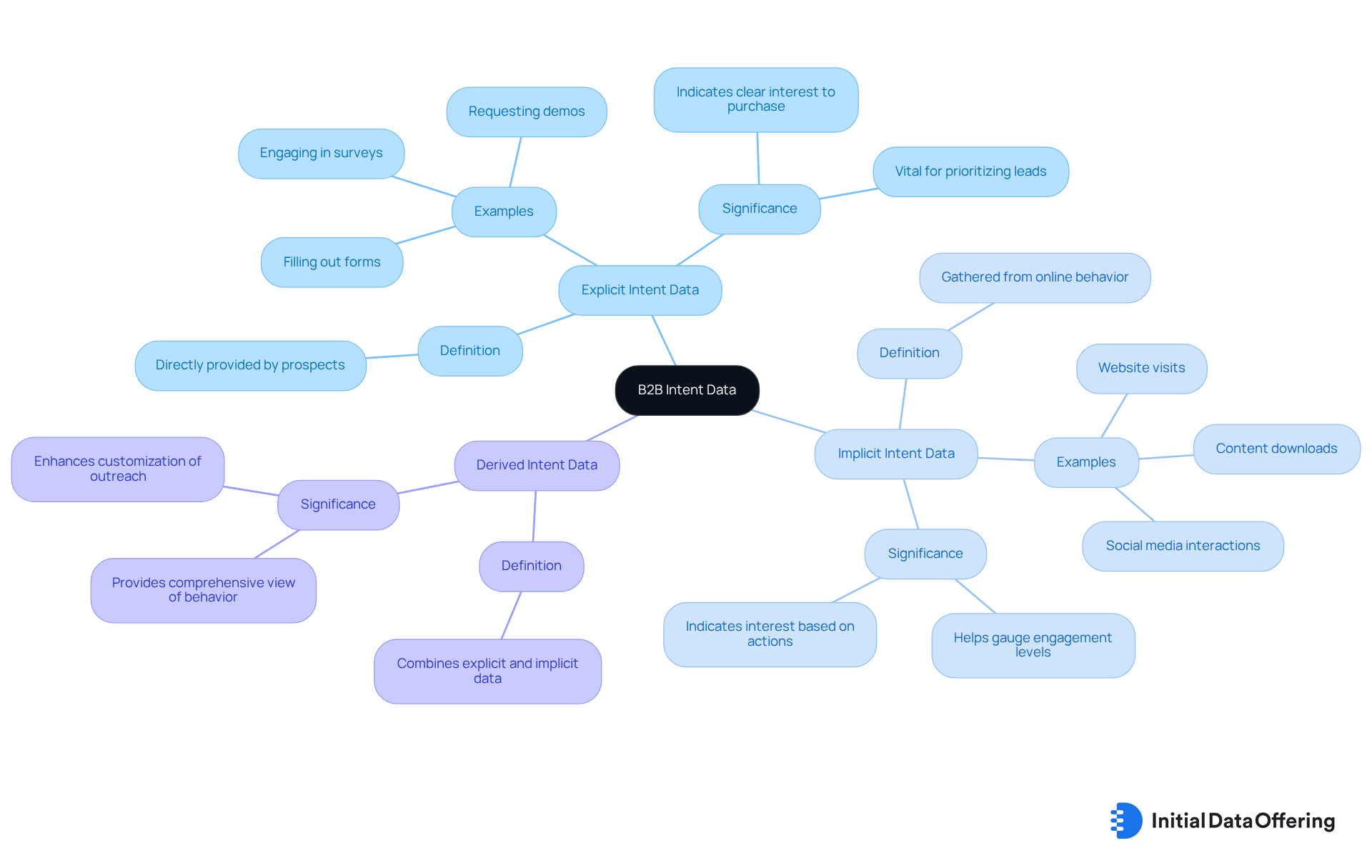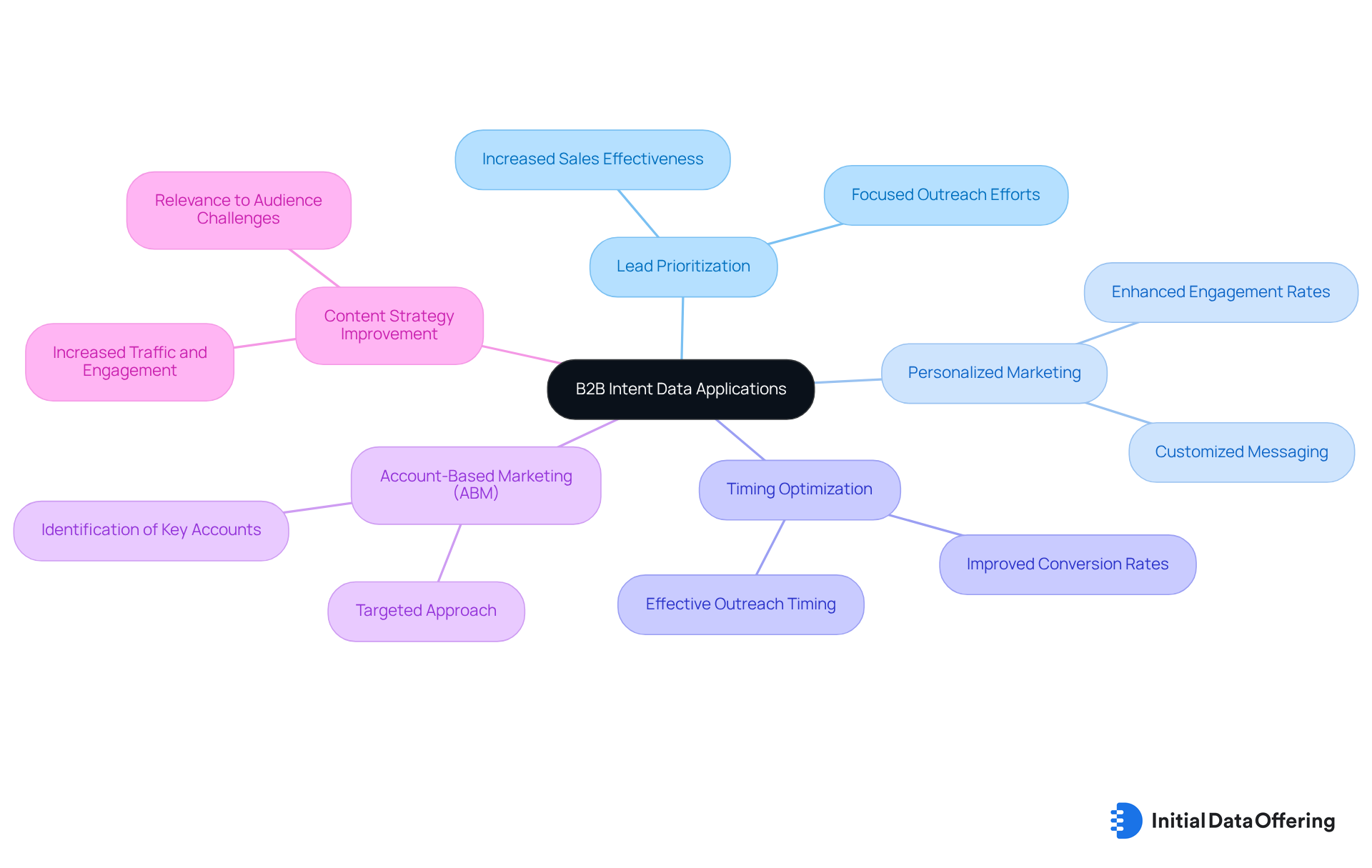Understanding B2B Intent Data: Definition, Types, and Applications

Understanding B2B Intent Data: Definition, Types, and Applications
Overview
B2B intent data encompasses insights derived from the online behavior of prospective business buyers, revealing their interest in specific products or services. This information is vital for enhancing marketing effectiveness and driving sales growth.
Businesses can leverage three types of intent data:
- Explicit intent data is directly collected from user interactions.
- Implicit data is inferred from behavior patterns.
- Derived intent data combines various signals to provide a comprehensive view of buyer interest.
By refining targeting strategies, personalizing marketing efforts, and optimizing outreach timing, companies can significantly improve engagement and conversion rates.
How can your organization utilize these insights to enhance its marketing strategy? Consider the potential impact of effectively harnessing B2B intent data on your sales outcomes.
Introduction
B2B intent data has emerged as a game-changer in the marketing landscape. It provides businesses with critical insights into potential buyers' online behaviors and interests. By harnessing this data, organizations can tailor their marketing strategies to engage prospects more effectively, ultimately driving sales growth. However, as the reliance on data intensifies, how can companies ensure they are leveraging B2B intent data to its fullest potential? This article delves into the definition, types, and applications of B2B intent data, offering valuable insights for businesses seeking to enhance their marketing and sales efforts.
Define B2B Intent Data and Its Significance
B2B intent data encompasses insights derived from the online activities of prospective business purchasers, which indicate their interest in specific products or services. This dataset is invaluable for B2B marketers and sales teams, as it provides B2B intent data that allows them to identify prospects actively researching solutions tailored to their needs. By leveraging these insights, businesses can refine their promotional strategies, ensuring they engage potential customers more effectively.
The advantages of B2B purpose information are significant. Its ability to enhance targeting accuracy ensures that marketing efforts are focused on high-potential leads. This optimization of resource distribution ultimately leads to increased sales growth. For instance, a B2B software firm that integrated purpose information into its promotional strategy experienced a 30% rise in engagement from prospects interested in particular features, resulting in a 25% increase in conversions.
Moreover, the importance of purpose information is underscored by the fact that 98% of marketers consider it crucial for effective demand generation. This highlights its role in crafting successful marketing strategies and driving sales growth. How can your organization harness this valuable information to improve its marketing outcomes? By understanding and applying B2B intent data, companies can significantly enhance their engagement and conversion rates.

Explore Types of B2B Intent Data: Explicit, Implicit, and Derived
B2B purpose information can be classified into three primary categories: explicit, implicit, and derived.
Explicit Intent Data is directly provided by prospects through actions such as filling out forms, requesting demos, or engaging in surveys. This type of data demonstrates a clear interest and purpose to purchase, making it a vital component for sales teams aiming to prioritize leads. Significantly, 99% of major companies now employ purpose information and tracking tools, highlighting its importance in contemporary promotional strategies. By leveraging B2B intent data, businesses can enhance their targeting and improve conversion rates.
Implicit Intent Information is gathered from the online behavior of users, including website visits, content downloads, and social media interactions. This information indicates interest based on actions rather than direct statements, allowing businesses to gauge potential buyers' engagement levels. As the environment of B2B promotion evolves, the strategic application of B2B intent data is becoming crucial for demand generation managers. How might your organization use implicit signals to refine its outreach strategies?
Derived Intent Information combines both explicit and implicit information to provide a comprehensive view of a prospect's behavior. By analyzing patterns and signals from various sources, businesses can gain deeper insights into potential buyers' interests and readiness to engage. This comprehensive strategy allows companies to customize their outreach and promotional efforts more effectively, ultimately leading to improved engagement and higher conversion rates.
Grasping these categories of purpose information is vital for companies aiming to refine their promotional strategies and boost lead generation initiatives with B2B intent data. As the dependence on extensive information in promotional technology has grown, utilizing these insights can result in more significant client connections and enhanced sales. Additionally, the increasing interest in account-focused services emphasizes the significance of purpose information in effectively targeting high-value accounts. By addressing the challenges of lead generation, especially for startup companies, businesses can better navigate the complexities of the B2B landscape.

Apply B2B Intent Data: Use Cases in Marketing and Sales
B2B intent data plays a vital role in enhancing marketing and sales effectiveness, providing several key applications that can significantly boost campaign performance.
-
Lead Prioritization: This feature allows sales teams to identify prospects displaying high intent. The advantage is that it enables teams to focus their outreach efforts on leads with a higher likelihood of conversion, ultimately leading to increased sales effectiveness.
-
Personalized Marketing: By leveraging intent information, marketers can customize their messaging and content. The benefit here is enhanced engagement rates as the content aligns more closely with the specific interests and needs of prospective customers.
-
Timing Optimization: Understanding when prospects are actively researching solutions is crucial. This insight allows businesses to time their outreach effectively, ensuring they connect with leads at the optimal moment, which can lead to improved conversion rates.
-
Account-Based Marketing (ABM): Intent information supports ABM strategies by helping teams identify key accounts exhibiting buying signals. This targeted approach resonates more with specific organizations, enhancing the effectiveness of campaigns.
-
Content Strategy Improvement: Analyzing purpose information empowers businesses to create content that addresses the challenges and interests of their target audience. This relevance generates more traffic and engagement, further solidifying customer relationships.
These applications illustrate how B2B intent data can transform marketing and sales efforts, leading to improved conversion rates and stronger customer relationships. How can you leverage these insights in your own strategies?

Conclusion
B2B intent data is a powerful tool that offers businesses valuable insights into the online behaviors of potential customers, enabling more targeted marketing and sales strategies. By understanding the interests and intentions of prospects, companies can engage more effectively, which leads to increased conversion rates and overall sales growth.
The significance of B2B intent data is highlighted through its various types—explicit, implicit, and derived—and their applications in marketing and sales. Explicit data reveals direct interests through actions like form submissions, while implicit data captures user behavior. Derived data combines both for a comprehensive view. These categories empower businesses to:
- Prioritize leads
- Personalize marketing efforts
- Optimize timing
- Enhance account-based marketing strategies
Ultimately, leveraging B2B intent data is essential for organizations aiming to improve their marketing outcomes and navigate the complexities of the B2B landscape. By embracing these insights, businesses can enhance their engagement with potential customers and drive meaningful connections that result in sustainable growth. The call to action is clear: harness the power of B2B intent data to refine strategies and elevate success in an increasingly competitive market.
Frequently Asked Questions
What is B2B intent data?
B2B intent data refers to insights derived from the online activities of prospective business purchasers, indicating their interest in specific products or services.
Why is B2B intent data significant for marketers and sales teams?
It allows marketers and sales teams to identify prospects who are actively researching solutions tailored to their needs, enabling them to refine promotional strategies and engage potential customers more effectively.
How does B2B intent data enhance targeting accuracy?
By focusing marketing efforts on high-potential leads, B2B intent data optimizes resource distribution, which can lead to increased sales growth.
Can you provide an example of B2B intent data's impact on a company's performance?
A B2B software firm that integrated intent data into its promotional strategy saw a 30% rise in engagement from prospects interested in specific features, resulting in a 25% increase in conversions.
How important is B2B intent data for demand generation?
According to statistics, 98% of marketers consider B2B intent data crucial for effective demand generation, highlighting its role in crafting successful marketing strategies and driving sales growth.
How can organizations harness B2B intent data to improve marketing outcomes?
By understanding and applying B2B intent data, companies can significantly enhance their engagement and conversion rates.